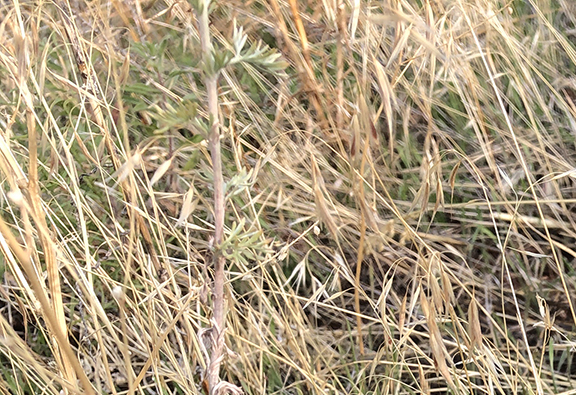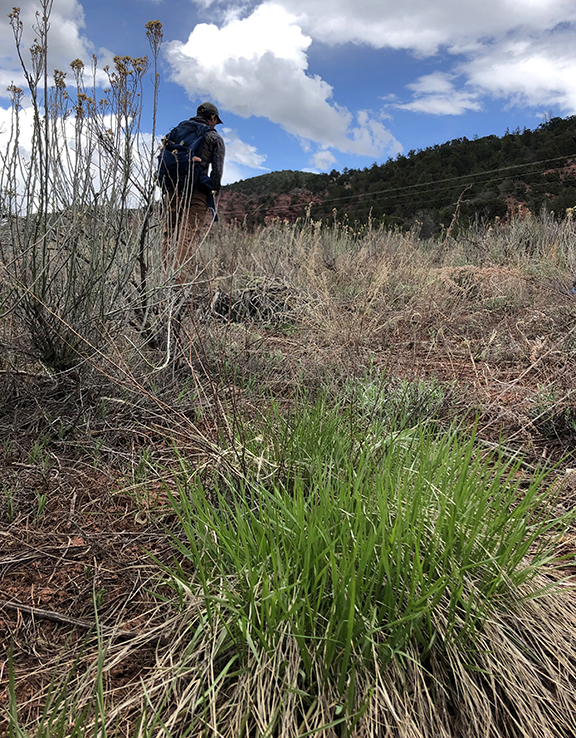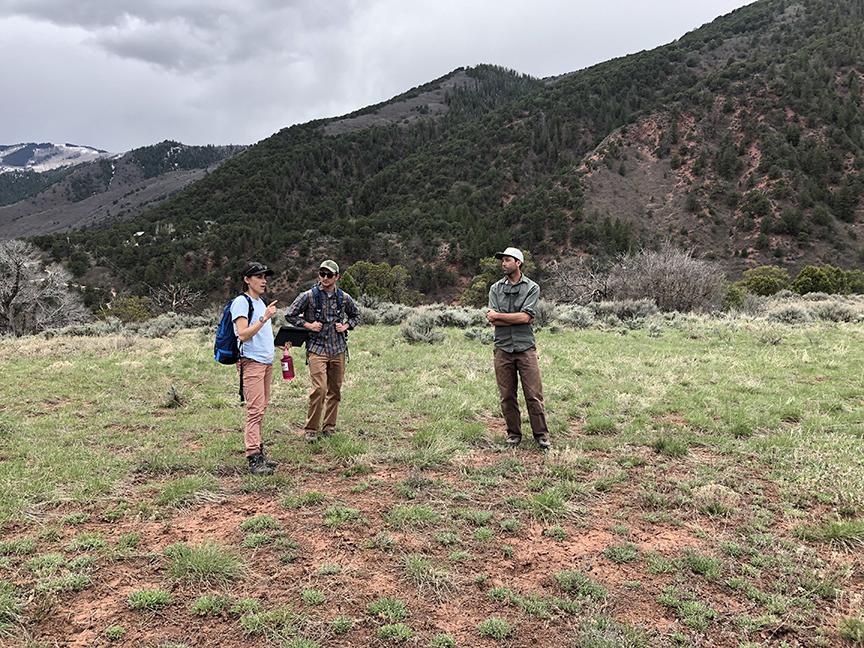Open Space battles cheatgrass (and wins, maybe)

Desiccated cheatgrass, now gone from Red Wind Point Open Space.
On a wind-swept mesa perched above the Crystal River at Red Wind Point Open Space, what’s most noticeable on the landscape is what’s not there – cheatgrass.
Atop the red cliff face that gives this open space its name sits a flat, 6-acre, disturbed meadow that has no public access. Left largely alone, it’s most notable for providing winter range for bighorn sheep. The low vegetation includes sagebrush, rabbitbrush and other native plants such as snakeweed and white prairie aster, as well as non-native grasses like crested wheatgrass, smooth brome and other varieties. Until 2021, cheatgrass (bromus techtorum) dominated swaths of the landscape.
“Virtually everyone is familiar with cheatgrass, even if they don’t know they are. It could be in your neighborhood, near parking lots or in your yard,” said Liza Mitchell, natural resource planner and ecologist for Pitkin County Open Space and Trails.
Like many invasive weeds, it outperforms and displaces many native species. It does well in drier environments and thrives in areas disturbed by fire, grazing, human activity and the like. Green in early spring, this cool-season grass provides forage for a very short period, then quickly dries to a tawny gold, unpalatable and drooping with sharply awned seeds that can cause eye injuries and jaw infections in livestock, according to the Montana Field Guide. It also becomes prime grassfire fuel.
“Some have likened cheatgrass to tissue paper covering the landscape – an easily ignited fuel that carries fire quickly and spreads rapidly,” noted Rea Orthner, an ecologist and botanist with Peak Ecological Services. Orthner has been tracking the apparently successful eradication of cheatgrass at Red Wind Point on behalf of Open Space and Trails.
Given the isolated nature of the meadow at Red Wind Point and the cheatgrass infestation on it, the area was deemed ideal for a trial use of Indizaflam, a relatively new restoration herbicide that uniquely attacks invasive annual grasses before the seeds germinate. Cheatgrass is an annual plant, dropping seeds in the fall that germinate the following year. The “pre-emergent” herbicide kills cheatgrass in the soil as the seed is germinating, before it can come up in the spring. With no new generation of cheatgrass to produce seeds, the infestation is eradicated.
An inspection of the open space meadow in May 2023 by Open Space and Trails staff revealed no cheatgrass. Orthner will return in June to formally assess the vegetation along six transects that have been established to monitor the effects of the treatment over time. Indizaflam was first applied in November 2020; a follow-up treatment of areas that were initially missed occurred in the summer of 2022.
Ideally, the meadow won’t need another round of treatment, as the heavy seeds of cheatgrass do not spread long distances via wind. They are more likely to be transported by getting stuck to clothes, animals and machinery, or lodged in hay or strawbales.
The pros and cons of herbicide
Using a chemical herbicide on an open space is always a carefully considered strategy, according to Mitchell.
“Red Wind Point was the perfect place to try this treatment and, realistically, sometimes there is no other way to effectively combat widespread, invasive weeds,” Mitchell said.
Between 2020 and 2022, the test area at Red Wind Point saw a 70 percent reduction in the overall cover of cheatgrass. However, other native forbs were impacted, as well. Diffuse groundsmoke, Douglas’ knotweed, narrowleaf mountain trumpet and pygmy rock jasmine were all commonly observed along the transects in 2020, but notably absent in 2021, Orthner reported. The herbicide likely inhibited their seed germination. But, in 2022, rock jasmine and mountain trumpet were again present along one of the transects.
There is now bare ground in areas of the meadow that were once choked with cheatgrass. Native plants will have a better chance of spreading into those areas, and reseeding the bare areas with native species is also a possibility, Mitchell said.
Use of the herbicide to eradicate cheatgrass may not be an option on all open spaces where the species is a problem, but the Red Wind Point experiment can help guide its use not only on open space, but on other public and private lands where cheatgrass is a significant problem, according to Mitchell.
The spread of cheatgrass
Cheatgrass originated in Europe or Eurasia and was introduced to the United States in the 1800s as a contaminant in seed and straw, according to the U.S. Geological Survey. It is now considered one of the biggest threats to rangeland in the West, covering 50 to 100 million acres, according to various estimates.
“Cheatgrass degrades wildlife habitat, diminishes crop production and cattle forage, accelerates wildfires and reduces the ability of grasslands to effectively sequester carbon,” according to the National Wildlife Federation.
The species apparently earned its common name early on, though sources differ on the specifics. Some say pioneer farmers noticed it reduced their wheat yields and, feeling cheated, named it “cheatgrass.” Or, it may have earned the name because it dries up quickly and its seeds stick to the mouthparts of animals, “cheating” them of nutrition.
At Red Wind Point, however, local bighorn sheep may find the forage is improving.
– By Pitkin County Open Space and Trails

Native bunchgrass, but not cheatgrass, at Red Wind Point Open Space.

Open Space and Trails resource staffers observe the changes at Red Wind Point.
